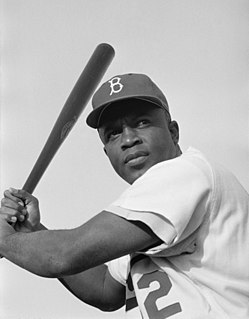
Jack Roosevelt Robinson was an American professional baseball player who became the first African American to play in Major League Baseball (MLB) in the modern era. Robinson broke the baseball color line when he started at first base for the Brooklyn Dodgers on April 15, 1947. When the Dodgers signed Robinson, they heralded the end of racial segregation in professional baseball that had relegated black players to the Negro leagues since the 1880s. Robinson was inducted into the Baseball Hall of Fame in 1962.

The Los Angeles Dodgers are an American professional baseball team based in Los Angeles, California. The Dodgers compete in Major League Baseball (MLB) as a member club of the National League (NL) West division. Established in 1883 in the city of Brooklyn, which later became a borough of New York City, the team joined the NL in 1890 as the Brooklyn Bridegrooms and assumed several different monikers thereafter before finally settling on the name Dodgers in 1932. From the 1940s through the mid-1950s, the Dodgers developed a fierce cross-town rivalry with the New York Yankees as the two clubs faced each other in the World Series seven times, with the Dodgers losing the first five matchups before defeating them to win the franchise's first title in 1955. It was also during this period that the Dodgers made history by breaking the baseball color line in 1947 with the debut of Jackie Robinson, the first African-American to ever play in the Major Leagues. Another major milestone was reached in 1956 when Don Newcombe became the first player ever to win both the Cy Young Award and the NL MVP in the same season.

Roy Campanella, nicknamed "Campy", was an American baseball player, primarily as a catcher. The Philadelphia native played in the Negro leagues and Mexican League for 9 years before entering the minor leagues in 1946. He made his Major League Baseball (MLB) debut in 1948 for the Brooklyn Dodgers, for whom he played until 1957. His playing career ended when he was paralyzed in an automobile accident in January 1958. He is widely considered to be one of the greatest catchers in the history of the game.
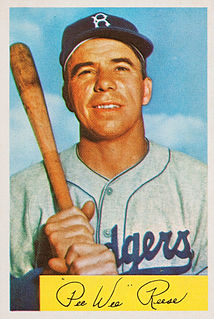
Harold Peter Henry "Pee Wee" Reese was an American professional baseball player. He played in Major League Baseball as a shortstop for the Brooklyn and Los Angeles Dodgers from 1940 to 1958. A ten-time All Star, Reese contributed to seven National League championships for the Dodgers and was inducted into the Baseball Hall of Fame in 1984. Reese is also famous for his support of his teammate Jackie Robinson, the first African American player in the major leagues's modern era, especially in Robinson's difficult first years.

Donald Newcombe, nicknamed "Newk", was an American professional baseball pitcher in Negro league and Major League Baseball who played for the Newark Eagles (1944–45), Brooklyn/Los Angeles Dodgers, Cincinnati Reds (1958–1960), and Cleveland Indians (1960).

Wilbert Robinson, nicknamed "Uncle Robbie", was an American catcher, coach and manager in Major League Baseball. He was inducted into the Baseball Hall of Fame in 1945.

Adolfo Domingo De Guzmán "Dolf" Luque was a Cuban starting pitcher in Major League Baseball (MLB) from 1914 to 1935. Luque was enshrined in the Cuban Baseball Hall of Fame and the Cincinnati Reds Hall of Fame in 1967, as well as in the Mexican Baseball Hall of Fame in 1985. Luque was not only the first Latino pitcher in the MLB, but also the first to win a World Series victory, and the first to lead the Leagues in wins and shutouts.
The Montreal Royals were a minor league professional baseball team in Montreal, Quebec, from 1897–1917 and 1928–60. A member of the International League, the Royals were the top farm club of the Brooklyn Dodgers from 1939; pioneering African-American player Jackie Robinson was a member for the 1946 season. The 1946 Royals were recognized as one of the 100 greatest minor league teams of all time.

Edward Raymond Stanky was an American professional baseball second baseman, shortstop and manager. He played in Major League Baseball (MLB) for the Chicago Cubs, Brooklyn Dodgers, Boston Braves, New York Giants, and St. Louis Cardinals between 1943 and 1953. He was born in Philadelphia, Pennsylvania.

Salvatore Anthony Maglie was an American Major League Baseball pitcher and later, a scout and a pitching coach. He played from 1945 to 1958 for the New York Giants, Cleveland Indians, Brooklyn Dodgers, New York Yankees, and St. Louis Cardinals. Maglie was known as "Sal the Barber", because he gave close shaves—that is, pitched inside to hitters. A gentle personality off the field went unnoticed during games, his foreboding physical appearance contributing to his menacing presence on a pitcher's mound. He was the last of 14 players to play for the Giants, Dodgers and Yankees at a time when all three teams were in New York City. During a 10-year major league baseball career, Maglie compiled 119 wins, 862 strikeouts, and a 3.15 earned run average.

Joseph Black was an American right-handed pitcher in Negro league and Major League Baseball for the Brooklyn Dodgers, Cincinnati Redlegs, and Washington Senators who became the first black pitcher to win a World Series game, in 1952.
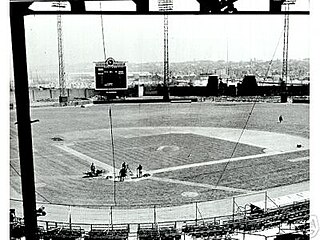
The Jersey City Giants was the name of a high-level American minor league baseball franchise that played in Jersey City, New Jersey, as the top farm system affiliate of the New York Giants from 1937 through 1950. The Jersey City club played in the International League. They were commonly referred to as the Little Giants.
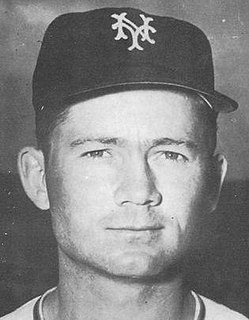
David Carlous Williams was an American professional baseball player and coach. During his Major League Baseball career, spent entirely with the New York Giants of the National League, the second baseman appeared in 517 games over six seasons, and was selected to the 1953 NL All-Star team. Williams was listed as 5 feet 10 inches (1.78 m) tall and 165 pounds (75 kg), and batted and threw right-handed. He was born in Dallas, Texas, where he graduated from Sunset High School in 1945.

Homer Elliot "Dixie" Howell was an American professional baseball catcher. He appeared in eight seasons in Major League Baseball (MLB) between 1947 and 1956 for the Pittsburgh Pirates, Cincinnati Reds and Brooklyn Dodgers.

Jackie Robinson Day is a traditional event which occurs annually on April 15 in Major League Baseball (MLB), commemorating and honoring the day Jackie Robinson made his major league debut. Celebrated at MLB ballparks, on that one day, all players, coaches, and managers on both teams, and the umpires, wear Robinson's uniform number, 42. April 15 was Opening Day in 1947, Robinson's first season in the major leagues.
Kenneth Wayne Trinkle was an American professional baseball player, a relief pitcher, in Major League Baseball. He played with the New York Giants from 1943–48, and the Philadelphia Phillies in 1949. As a relief specialist in Major League Baseball, he led the National League in appearances in 1946 and 1947. He threw and batted right-handed during his baseball career.

John Richard Wright was a Negro League pitcher who played briefly in the International League of baseball's minor leagues in 1946, and was on the roster of the Montreal Royals at the same time as Jackie Robinson, making him a plausible candidate to have broken the baseball color barrier. Instead, Wright was demoted from Montreal and returned the next season to the Negro Leagues.

The Brooklyn Dodgers were a Major League baseball team, active primarily in the National League from 1884 until 1957, after which the club moved to Los Angeles, California, where it continues its history as the Los Angeles Dodgers. The team moved west at the same time as its longtime rival, the New York Giants, also in the National League, relocated to San Francisco in northern California as the San Francisco Giants. The team's name derived from the reputed skill of Brooklyn residents at evading the city's trolley streetcar network. The Dodgers played in two stadiums in South Brooklyn, each named Washington Park, and at Eastern Park in the neighborhood of Brownsville before moving to Ebbets Field in the neighborhood of Flatbush in 1913. The team is noted for signing Jackie Robinson in 1947 as the first black player in the modern major leagues.
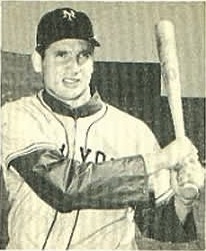
The 1951 National League tie-breaker series was a best-of-three playoff series at the conclusion of Major League Baseball's (MLB) 1951 regular season to decide the winner of the National League (NL) pennant. The games were played on October 1, 2, and 3, 1951, between the New York Giants and Brooklyn Dodgers. It was necessary after both teams finished the season with identical win–loss records of 96–58. It is most famous for the walk-off home run hit by Bobby Thomson of the Giants in the deciding game, which has come to be known as baseball's "Shot Heard 'Round the World".
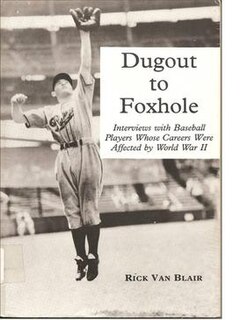
Dugout to Foxhole: Interviews with Baseball Players Whose Careers Were Affected by World War II is a 1994 book written by Rick Van Blair. The book has been cited as a reference source for other baseball books.


















